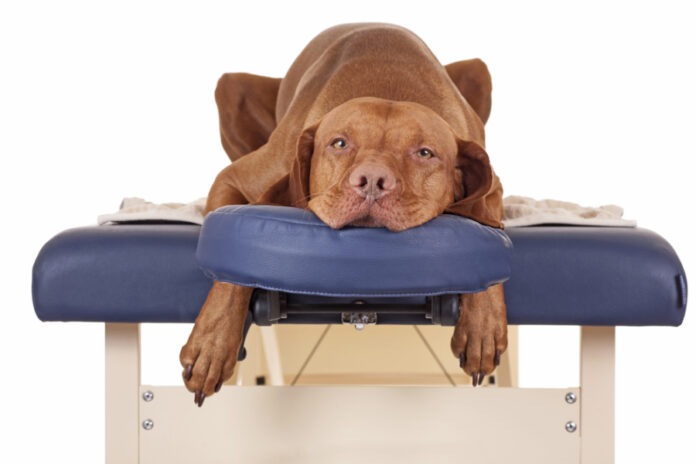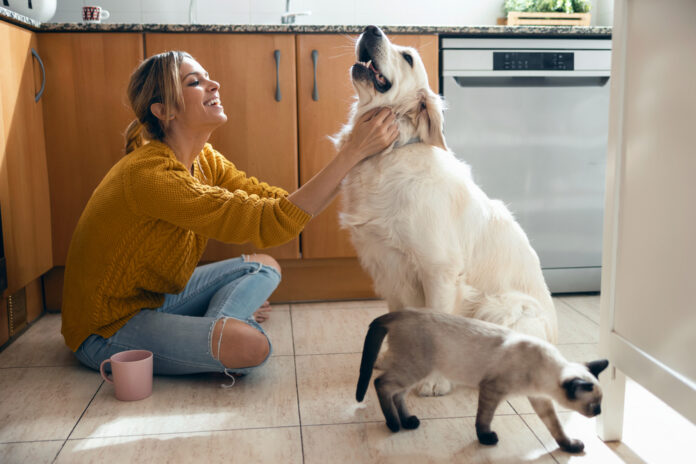How to keep your dog or cat hydrated
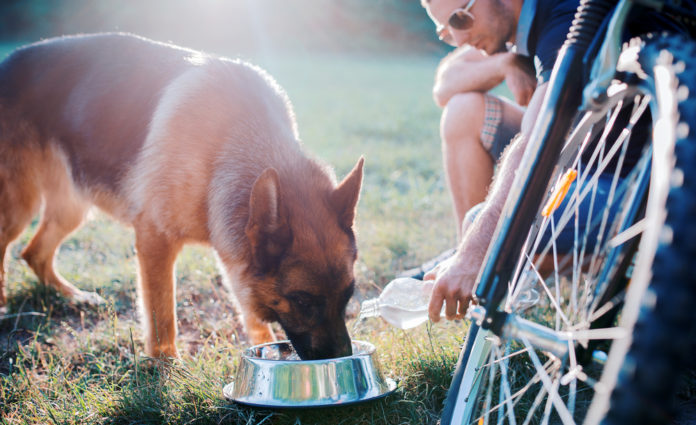
Adequate water intake is essential to good health, particularly during the hot summer months. Here’s why, along with tips on keeping your dog or cat hydrated.
As summer arrives, fresh adventures await our four-legged friends and their human companions. Maintaining proper health is vital to enjoying these grand adventures, and one key component, especially for outdoor enthusiasts, is maintaining adequate hydration. Take a look at why keeping your dog or cat hydrated is so important to his health, and how to help ensure he’s drinking enough water.
What does hydration mean?
When we think of hydration, the first thing that usually comes to mind is water. Good ol’ H2O. Water makes up most of our bodies – and those of our animals – and its role in maintaining good health is unparalleled.
While water is the major contributor to hydration, it doesn’t work alone. As we take water into our bodies, it interacts with a number of physiological pathways that incorporate it into everyday functions necessary for maintaining proper cellular health and homeostatic balance in the blood, tissues, and organs.
/* custom css */
.tdi_15.td-a-rec{
text-align: center;
}.tdi_15 .td-element-style{
z-index: -1;
}.tdi_15.td-a-rec-img{
text-align: left;
}.tdi_15.td-a-rec-img img{
margin: 0 auto 0 0;
}@media (max-width: 767px) {
.tdi_15.td-a-rec-img {
text-align: center;
}
}
Why is hydration so important?
Water nourishes every cell in the body. Without proper hydration, the normal everyday functions of the body are impaired. The hydration of cells, for example, is important to the intracellular functions needed to provide cellular respiration, energy, and growth. Without proper hydration, cells would not be able to effectively communicate with one another. As dehydration worsens, neurological imbalances and decreased mental states can occur. Eventually, cells can become diseased and die.
Hydration is also very important for the composition and movement of blood within the body. Red and white blood cells, along with antigens and antibodies, play an optimal role in the immune system. Without proper hydration, the body’s immune system may not function at peak efficiency, more easily opening the door for illnesses to develop.
Did you know? Serum, the liquid part of blood when separated, is comprised of fluid and proteins. It can be used for diagnostic testing, but can be harder to obtain in dehydrated animals and could result in the inability to perform much-needed lab tests.
In well-hydrated animals, blood flows very easily throughout the body. It circulates and nourishes all the organs, keeping them happy and healthy. The reverse is true for dehydrated animals. Their blood will not flow as easily and becomes very thick and viscous. It is almost as if the blood stagnates or stalls within the vessels. When this occurs, problems such as blood clots and poor circulation can lead to organ dysfunction.
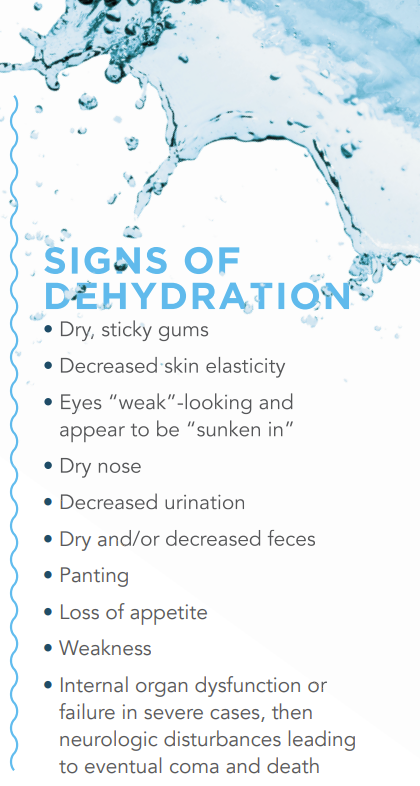 Signs of dehydration in your dog or cat
Signs of dehydration in your dog or cat
Signs of dehydration can vary based on its severity and any disease process that may be occurring. After exercise, for example, an animal pet will need to drink enough water to replace what was lost during the activity. When this occurs, the dog or cat’s hydration usually returns to normal with no ongoing losses. However, an animal suffering from an illness such as diarrhea is more likely to become dehydrated because of ongoing fluid losses. In these cases, the dog or cat may need to drink more than the usual amount of water to try and balance out the ongoing losses and maintain hydration.
Did you know? Sometimes, veterinary intervention may be needed to administer IV fluids to help rehydrate the animal.
While a definitive diagnosis of dehydration can be determined based on laboratory tests performed by your veterinarian, there are some common signs you can watch for and ways to help prevent severe dehydration from occurring in your dog or cat.
- When an animal begins to become dehydrated, the body tries to protect the most vital organs such as the brain, heart, lungs, and kidneys. This in turn leaves the skin and outer organs showing some initial signs of dehydration. As a dog or cat become more dehydrated, his overall appearance will change. He can look unkempt and “sickly.” His coat can become dry and brittle and his skin loses its normal elasticity. Testing skin elasticity is a quick assessment for dehydration (see sidebar
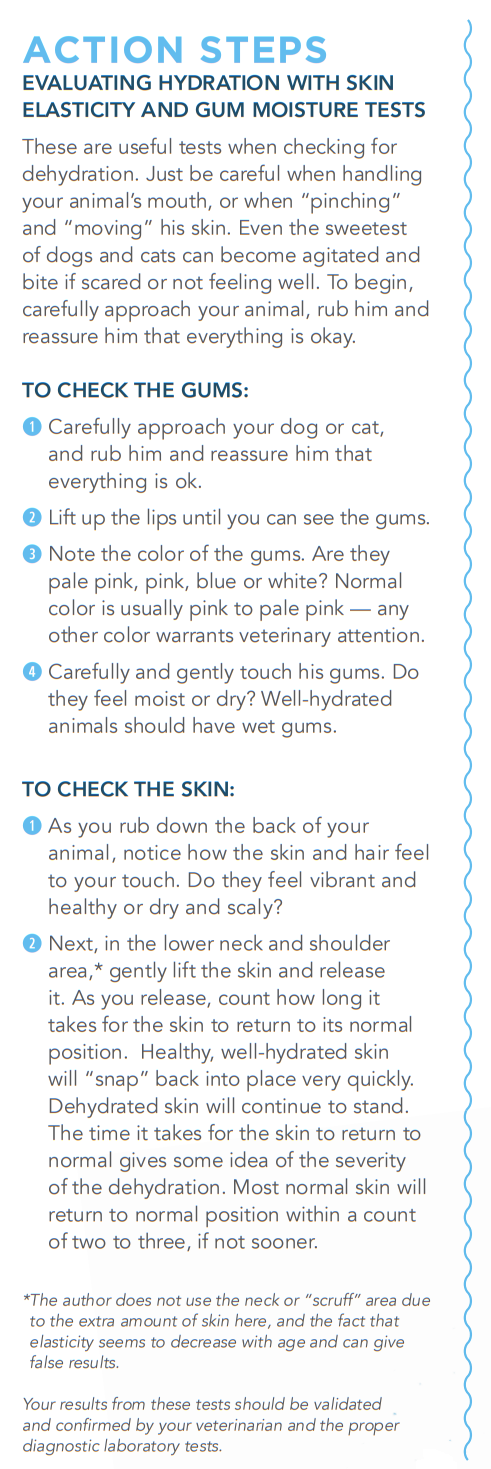 ).
). - Additionally, the mouth may become dry and sticky. The saliva, which should be wet and stringy, becomes thick and viscous as secretions begin to dry up, and the gums get very dry.
- As dehydration and electrolyte imbalances worsen, animals may exhibit behavioral and neurological signs. They can become restless and agitated. They may try to seek out any source of liquid, even toxic substances, in an effort to try and rehydrate themselves. As the dehydration continues, the animal will become ataxic, walking with an abnormal and unsteady gait; and as he becomes weaker, he will be unable to stand and mental functions become impaired.
- If dehydration goes unchecked and is not treated, the most severe cases can progress to organ failure, or coma and death.
3 steps to keeping him hydrated
During the course of a day, both humans and animals lose a given amount of water through normal physiological functions such as respiration and excretion (urination and defecation). A homeostatic balance is maintained by replacing what is lost. This can be achieved in numerous ways and includes the intake of water and fluids as well as moisture derived from food.
- Always provide fresh, clean, pure water, and change it every day. In some cases, particularly with cats, animals may prefer the water to be moving instead of still. To encourage more water intake, invest in a water fountain made for pets.
- Another important factor is your dog or cat’s food. It should provide not only optimal species-specific nutrition, but also the proper moisture content.
Did you know? Healthy treats can also help with adding extra moisture to the body, and can include certain fruits such as watermelon and cucumbers. Remove seeds and rinds first.
- If you and/or your animal are going to be doing strenuous exercise, or spending extended periods in an environment where dehydration could easily occur, make sure to provide plenty of fresh water. It is equally important to have a plan in place if your pet does become dehydrated, or develops a condition, such a diarrhea or vomiting, that could lead to dehydration. Knowing when to get to the veterinarian, and which clinics are open for emergency care, will save time and stress.
Caught in its earliest stages, dehydration is easy to remedy. By being informed and following the advice in this article, you and your four-legged companion can relax and enjoy the summer together!
/* custom css */
.tdi_16.td-a-rec{
text-align: center;
}.tdi_16 .td-element-style{
z-index: -1;
}.tdi_16.td-a-rec-img{
text-align: left;
}.tdi_16.td-a-rec-img img{
margin: 0 auto 0 0;
}@media (max-width: 767px) {
.tdi_16.td-a-rec-img {
text-align: center;
}
}



